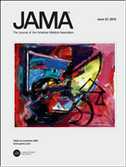Gut:饮食中抗氧化剂摄入或阻断胰腺癌发病风险
2012-07-27 T.Shen 生物谷
近日,刊登在国际杂志Gut上的一项研究报告指出,增加饮食中抗氧化剂(维生素C、E、硒)的深入可以帮助2/3的人们切断发展为胰腺癌的风险。世界范围内胰腺癌每年可致超过25万人死亡。每年在英国有7500人被诊断出患上了胰腺癌。胰腺癌的预后效果是所有癌症中最差的,预后5年之后,仅仅有3%的人会幸存下来,当然了基因、吸烟和II型糖尿病也是影响因子,但是饮食占据着很大一部分原因。 研究者在1993年至19
近日,刊登在国际杂志Gut上的一项研究报告指出,增加饮食中抗氧化剂(维生素C、E、硒)的深入可以帮助2/3的人们切断发展为胰腺癌的风险。世界范围内胰腺癌每年可致超过25万人死亡。每年在英国有7500人被诊断出患上了胰腺癌。胰腺癌的预后效果是所有癌症中最差的,预后5年之后,仅仅有3%的人会幸存下来,当然了基因、吸烟和II型糖尿病也是影响因子,但是饮食占据着很大一部分原因。
研究者在1993年至1997年期间追踪了超过23,50040个个体的信息,每一个参与者填写了其饮食日记,详细地记载了其每种食物的用量以及方法、如何准备等等信息。调查中的人在10年内有49%的人发展成了胰腺癌,截止到2010年比例增加到了86%,在诊断出疾病之后,他们仅仅生存了6个月。
研究结果揭示,饮食中摄入维生素C、E和硒的参与者患胰腺癌的比例相比不摄入的人群仅仅为67%。文章中,研究者表示,抗氧化物或许会中和食品影响正常细胞活性的有害作用,而且可以抑制遗传性的程序影响,同时可以刺激免疫系统发挥作用。
抗氧化剂补充的临床试验结果并没有产生可喜的结果,有可能是因为食物中的这些抗氧化剂如维生素C和抗氧化剂补充物中的不一样。研究者最后表示,通过流行病学调查,如果因果关系可靠,那么对于人们的饮食建议将会帮助人们预防胰腺癌。
编译自:High Dietary Antioxidant Intake Might Cut Pancreatic Cancer Risk

doi:10.1136/gutjnl-2011-301908
PMC:
PMID:
Dietary antioxidants and the aetiology of pancreatic cancer: a cohort study using data from food diaries and biomarkers
Paul J R Banim1, Robert Luben2, Alison McTaggart2, Ailsa Welch1, Nicholas Wareham3, Kay-Tee Khaw2, Andrew R Hart1,4
Objective To investigate whether the dietary antioxidants vitamins C and E, selenium and zinc decrease the risk of developing pancreatic cancer, for the first time using 7-day food diaries, the most accurate dietary methodology in prospective work. Design 23 658 participants, aged 40–74 years, recruited into the EPIC-Norfolk Study completed 7-day food diaries which recorded foods, brands and portion sizes. Nutrient intakes were calculated in those later diagnosed with pancreatic cancer and in 3970 controls, using a computer program with information on 11 000 foods. Vitamin C was measured in serum samples. The HRs of developing pancreatic cancer were estimated across quartiles of intake and thresholds of the lowest quartile (Q1) against a summation of the three highest (Q2–4). Results Within 10 years, 49 participants (55% men), developed pancreatic cancer. Those eating a combination of the highest three quartiles of all of vitamins C and E and selenium had a decreased risk (HR=0.33, 95% CI 0.13 to 0.84, p<0.05). There were threshold effects (Q2–4 vs Q1) for selenium (HR=0.49, 95% CI 0.26 to 0.93, p<0.05) and vitamin E (HR=0.57, 95% CI 0.29 to 1.09, p<0.10). The HRs of quartiles for antioxidants, apart from zinc, were <1, but not statistically significant. For vitamin C, there was an inverse association with serum measurements (HR trend=0.67, 95% CI 0.49 to 0.91, p=0.01), but the threshold effect from diaries was not significant (HR=0.68, 95% CI 0.37 to 1.26). Conclusion The results support measuring antioxidants in studies investigating the aetiology of pancreatic cancer. If the association is causal, 1 in 12 cancers might be prevented by avoiding the lowest intakes.
本网站所有内容来源注明为“梅斯医学”或“MedSci原创”的文字、图片和音视频资料,版权均属于梅斯医学所有。非经授权,任何媒体、网站或个人不得转载,授权转载时须注明来源为“梅斯医学”。其它来源的文章系转载文章,或“梅斯号”自媒体发布的文章,仅系出于传递更多信息之目的,本站仅负责审核内容合规,其内容不代表本站立场,本站不负责内容的准确性和版权。如果存在侵权、或不希望被转载的媒体或个人可与我们联系,我们将立即进行删除处理。
在此留言










#阻断#
57
#氧化剂#
66
#癌发病#
64
#抗氧化剂#
71